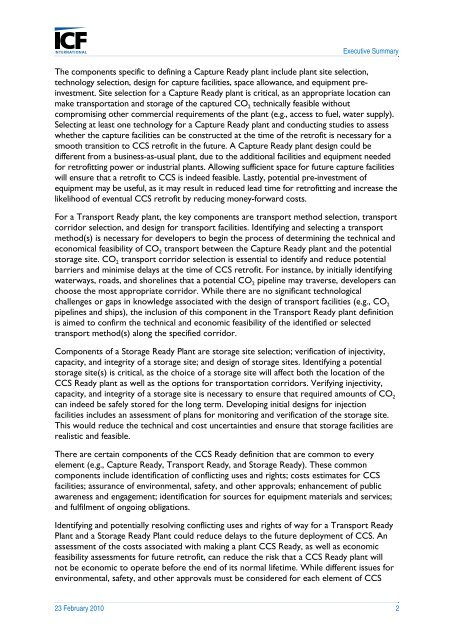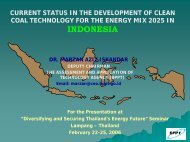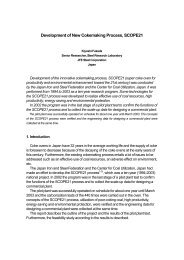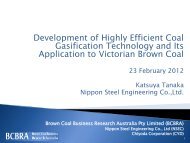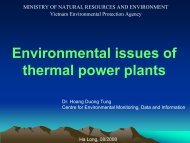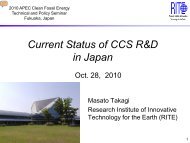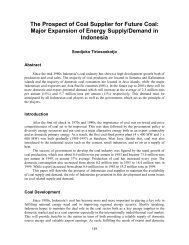Defining CCS Ready: An Approach to An International Definition
Defining CCS Ready: An Approach to An International Definition
Defining CCS Ready: An Approach to An International Definition
- No tags were found...
You also want an ePaper? Increase the reach of your titles
YUMPU automatically turns print PDFs into web optimized ePapers that Google loves.
Executive SummaryThe components specific <strong>to</strong> defining a Capture <strong>Ready</strong> plant include plant site selection,technology selection, design for capture facilities, space allowance, and equipment preinvestment.Site selection for a Capture <strong>Ready</strong> plant is critical, as an appropriate location canmake transportation and s<strong>to</strong>rage of the captured CO 2 technically feasible withoutcompromising other commercial requirements of the plant (e.g., access <strong>to</strong> fuel, water supply).Selecting at least one technology for a Capture <strong>Ready</strong> plant and conducting studies <strong>to</strong> assesswhether the capture facilities can be constructed at the time of the retrofit is necessary for asmooth transition <strong>to</strong> <strong>CCS</strong> retrofit in the future. A Capture <strong>Ready</strong> plant design could bedifferent from a business-as-usual plant, due <strong>to</strong> the additional facilities and equipment neededfor retrofitting power or industrial plants. Allowing sufficient space for future capture facilitieswill ensure that a retrofit <strong>to</strong> <strong>CCS</strong> is indeed feasible. Lastly, potential pre-investment ofequipment may be useful, as it may result in reduced lead time for retrofitting and increase thelikelihood of eventual <strong>CCS</strong> retrofit by reducing money-forward costs.For a Transport <strong>Ready</strong> plant, the key components are transport method selection, transportcorridor selection, and design for transport facilities. Identifying and selecting a transportmethod(s) is necessary for developers <strong>to</strong> begin the process of determining the technical andeconomical feasibility of CO 2 transport between the Capture <strong>Ready</strong> plant and the potentials<strong>to</strong>rage site. CO 2 transport corridor selection is essential <strong>to</strong> identify and reduce potentialbarriers and minimise delays at the time of <strong>CCS</strong> retrofit. For instance, by initially identifyingwaterways, roads, and shorelines that a potential CO 2 pipeline may traverse, developers canchoose the most appropriate corridor. While there are no significant technologicalchallenges or gaps in knowledge associated with the design of transport facilities (e.g., CO 2pipelines and ships), the inclusion of this component in the Transport <strong>Ready</strong> plant definitionis aimed <strong>to</strong> confirm the technical and economic feasibility of the identified or selectedtransport method(s) along the specified corridor.Components of a S<strong>to</strong>rage <strong>Ready</strong> Plant are s<strong>to</strong>rage site selection; verification of injectivity,capacity, and integrity of a s<strong>to</strong>rage site; and design of s<strong>to</strong>rage sites. Identifying a potentials<strong>to</strong>rage site(s) is critical, as the choice of a s<strong>to</strong>rage site will affect both the location of the<strong>CCS</strong> <strong>Ready</strong> plant as well as the options for transportation corridors. Verifying injectivity,capacity, and integrity of a s<strong>to</strong>rage site is necessary <strong>to</strong> ensure that required amounts of CO 2can indeed be safely s<strong>to</strong>red for the long term. Developing initial designs for injectionfacilities includes an assessment of plans for moni<strong>to</strong>ring and verification of the s<strong>to</strong>rage site.This would reduce the technical and cost uncertainties and ensure that s<strong>to</strong>rage facilities arerealistic and feasible.There are certain components of the <strong>CCS</strong> <strong>Ready</strong> definition that are common <strong>to</strong> everyelement (e.g., Capture <strong>Ready</strong>, Transport <strong>Ready</strong>, and S<strong>to</strong>rage <strong>Ready</strong>). These commoncomponents include identification of conflicting uses and rights; costs estimates for <strong>CCS</strong>facilities; assurance of environmental, safety, and other approvals; enhancement of publicawareness and engagement; identification for sources for equipment materials and services;and fulfilment of ongoing obligations.Identifying and potentially resolving conflicting uses and rights of way for a Transport <strong>Ready</strong>Plant and a S<strong>to</strong>rage <strong>Ready</strong> Plant could reduce delays <strong>to</strong> the future deployment of <strong>CCS</strong>. <strong>An</strong>assessment of the costs associated with making a plant <strong>CCS</strong> <strong>Ready</strong>, as well as economicfeasibility assessments for future retrofit, can reduce the risk that a <strong>CCS</strong> <strong>Ready</strong> plant willnot be economic <strong>to</strong> operate before the end of its normal lifetime. While different issues forenvironmental, safety, and other approvals must be considered for each element of <strong>CCS</strong>23 February 2010 2


